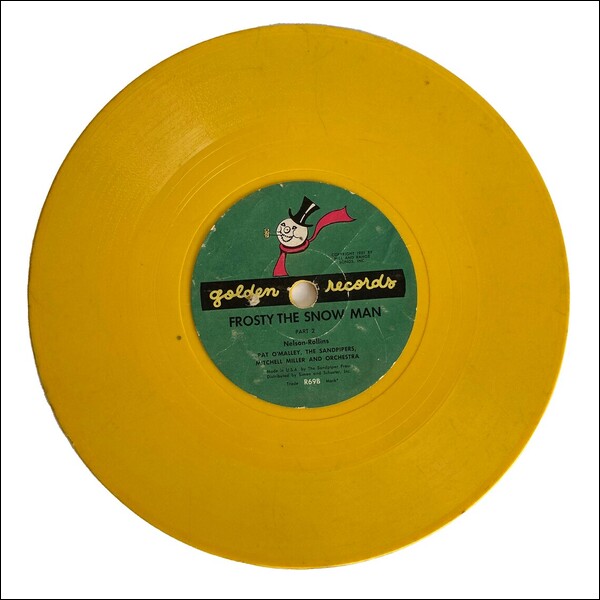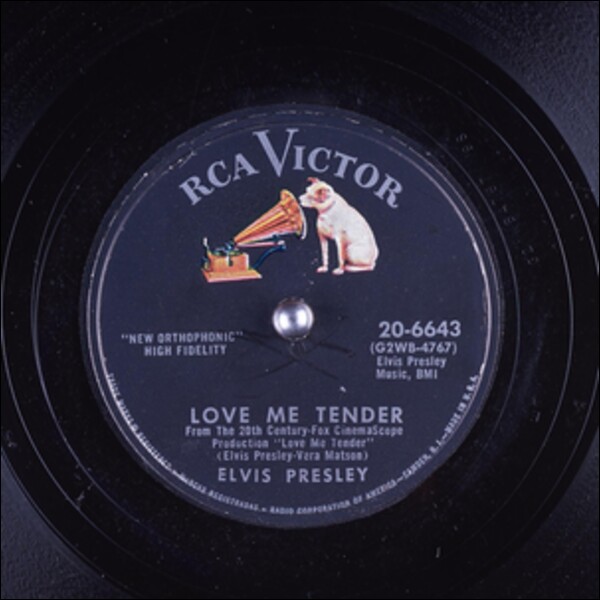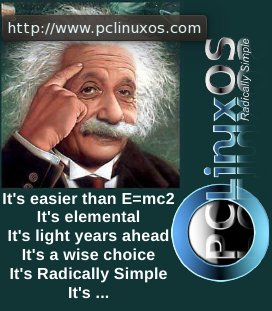| Previous
Page |
PCLinuxOS
Magazine |
PCLinuxOS |
Article List |
Disclaimer |
Next Page |
A 78 RPM Record Treasure Trove |
|
by Paul Arnote (parnote) Some of my fondest memories from my childhood involve spending an afternoon listening to little yellow 78 rpm records that we had as kids. They all had child themed songs or stories on them, with titles like Tubby the Tuba, the Pokey Little Puppy, and How Much Is That Doggie In The Window. Of course, they weren't all yellow, but that's the color that stands out in my mind (probably because yellow is my favorite color). The yellow ones were from Golden Records. But there were also red ones, typically branded Peter Pan Records. I remember other records in assorted colors. I even remember the odd black 45 rpm records mixed in, that required the adapter (called a spider) in the larger hole to be able to be played. Occasionally, we'd find child records "embedded" on the back of a box of cereal, like Cap'n Crunch or Wheaties. We played those, too, after carefully cutting out the back of the cereal box (only after we had eaten the cereal, of course). Me and my siblings would sometimes scuffle over who was going to get to play the cereal box record first.  Photo from Etsy seller, EpicVintageTreasures We played them on a small child size phonograph that was capable of playing records at 78, 45, and 33 1/3 rpms. We had a lot of these records. They were very popular in the 1950s and 1960s. We'd save up our allowance to be able to buy more of these records periodically. One of the stores my parents frequently shopped at had a large section of these records, and we always visited it every time we went to that particular store. From there, we would purchase new ones for prices between 29 and 69 cents each. It seems that these child focused phonograph records have become quite the collector's item. Of course, this happens with all sorts of things once they aren't produced any more. Depending on condition, the seller, the titles offered for sale, and a host of other assorted criteria, they now routinely sell for as much as $100 for a 29 item lot. Others sell on eBay for mostly between $6 and $12 per copy. The most expensive one I could find is a super rare 12" Vogue Picture Record (78rpm) - A Trip To Slumberland, Part 1 & 2, that usually sells for $2,200 to $2,500 whenever it does show up for sale. The guy that had it listed for sale was offering it at a bargain $1,800. Meanwhile, when I visited the home of my childhood best friend, his mom had an O-L-D crank-up Victrola record player. It didn't need to be plugged in. It just needed to be cranked up. We'd spend afternoons playing old 78 rpm records from the early 1900s. Those old records looked way different than any other records we were familiar with. They were 12 inches in diameter, and THICK. Some were as thick as 1/4". His mom had a "collection" of a few dozen of those old records, stored in a cabinet below the Victrola. Some of the songs were pretty good, while others made us laugh hysterically because they were just horribly bad. We're talking about the mid 1960s here. Fast forward to the early 1980s, and the emergence of CD audio (formally called Red Book Audio, co-developed by Philips and Sony in 1980). The first audio CD was offered for sale to the public for the first time in 1982. The crystal clear, digital sound of CDs, free from pops, scratches and skips, caused most in the music industry to sound the death toll for phonograph records. And, for a while, they were right. Phonograph records became more scarce than hen's teeth for a very long time. You can read more about CD audio's reign of the audio market here. CDs enjoyed market dominance for about 20 to 30 years, until they were replaced with digital audio files and streaming. Today, digital audio files and streaming rule the day. Even though CDs are still around, their market share is a mere shadow of what it once was. However, in the 2010s and early 2020s, phonograph records started making a comeback. Initially, that comeback was fueled by audiophiles, yearning for the "old fashioned" way of listening to recordings, complete with their pops, crackles and skips. Later generations of audio enthusiasts further fueled the resurgence of phonograph records, yearning for the audio that their parents and grandparents listened to, even with its limitations and drawbacks. More recently, and for the same reasons, cassette tapes have also started a resurgence in popularity. A Collection Of & For The Ages  So, you may be wondering exactly where this whole background story is going. Reminiscing about those days of my childhood, I started to wonder if anyone had taken the time to digitize their collections of these child records. I would love to be able to share them with my own kids. So far, I've not found any of those records that have been digitized and made available on the internet (but I'm not finished looking yet, either). But, that is how I found out about people collecting these items. It's also how I found, quite by accident, a whole collection of old 78 rpm records that have been digitized for posterity. Thanks to the Internet Archive, over 385,000 of these 78 rpm records have been digitized in the "The Great 78 Project" collection, digitized with the help of George Blood, L.P.. The oldest one I've personally found is from the 1920s. I've personally found music in the collection all the way up into at least the 1970s. The most represented decades appear to be the 1950s, followed by the 1940s, from what I've found. Titles from the very early 1900s and even the late 1800s are listed in the search filters, with 2013 being the latest date in the search filters. In this collection, I've discovered music from the U.S., France, Germany, Mexico, Brazil, Sweden, Canada, the U.K., Japan, and many other countries. As far as I can tell, most of the titles are from the U.S. Here's some of the artists I've stumbled across in the collection (in no particular order): Elvis Presley, Bill Haley and His Comets, Buddy Holly, Doris Day, Cab Calloway, Louis Armstrong, Jerry Lee Lewis, Guy Lombardo, Bing Crosby, Glenn Miller, Woody Guthrie, Xavier Cugat, Dorothy Lamour, Frank Sinatra, Artur Rubenstein, Billie Holiday, Hank Williams, The Platters, Ray Charles, Harry Belafonte, Duke Ellington, Lead Belly, Judy Garland, Rosemary Clooney, Gene Kelly, and many, many more.  There are literally tons of Christmas music in the collection, like "Rudolph The Red Nosed Reindeer," "Santa Claus Is Coming To Town," "White Christmas," and many more others than I can even begin to list here. Some of the other titles I've run across include "Jailhouse Rock," "Love Me Tender," "Minnie The Moocher," "Que Sera Sera," "Banana Boat," "Great Balls Of Fire," "Shake, Rattle & Roll," "House of the Rising Sun," and many, many more. The genres of music cover classical, country and western, swing, Big Band, rock, pop, instrumentals, marches, Christmas, ragtime, blues, jazz, and just about every other genre you can imagine. The vast majority of the collection is recorded using different size styluses, so there are multiple versions of each song presented. Some are even "lightly restored," where a lot of the pops, crackles and background hiss are eliminated or minimized. Those selections are marked "Restored," and I'll be the first to tell you that they sound really good. Of course, you can see for yourself, by listening to (or downloading) the "unrestored" versions. Or ... You Could Record Your Own Collection There's a strong possibility that some of you reading this article have your own collection of 78 rpm records at home. Or, you might know someone who has a collection of 78 rpm records. If so, it might be time to digitize those collections. Yes, you can still buy phonograph players that playback records recorded at 78 rpms. In fact, I was a bit surprised to see so many offered for sale on Amazon. Prices start at around $45 (U.S. dollars) for self-contained players, complete with their own built-in speakers that just playback phonographs. For about $20 more, you can get one with retro styling that also has Bluetooth capabilities and the abilities to record your vinyl records as either MP3 or WAV audio files, allowing you to archive your vinyl phonographs as digital recordings. Others record either MP3 or WAV audio files (one or the other), and one even has a cassette player and FM radio built in. On the model that plays cassette tapes, you can also digitize your cassette tape collection (hello 70s and 80s homebrew mix-tapes?). Many of these players allow using USB thumb drives and/or SD memory cards to record and store (archive) your audio recordings on. Thus, you then can manually transfer your recorded vinyl to your computer by just plugging either the USB thumb drive or the SD memory card into your computer and copy the files over to your computer's drive. Bluetooth allows you to connect wireless speakers or headphones/earbuds to the unit, or to stream music from your streaming devices to the player. The really nice thing about using these players is that there is nothing to install on your computer, other than the sound editing software (Audacity, anyone?) that you may want to use to clean up your recordings. The recording of your files is handled completely by the player. Summary Just about anyone should be able to find music that fits their musical tastes in this collection. The collection, albeit far from complete, is vast and varied. And, best of all, it's free. |



